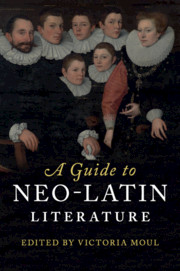Book contents
- A Guide to Neo-Latin Literature
- A Guide toNeo-Latin Literature
- Copyright page
- Dedication
- Contents
- Illustrations
- Contributors
- List of Neo-Latin Authors and Dates
- Acknowledgements
- Introduction
- Part I Ideas and Assumptions
- Part II Poetry and Drama
- Part III Prose
- Part IV Working with Neo-Latin Literature
- Bibliography
- Index
- References
Part I - Ideas and Assumptions
Published online by Cambridge University Press: 02 March 2017
- A Guide to Neo-Latin Literature
- A Guide toNeo-Latin Literature
- Copyright page
- Dedication
- Contents
- Illustrations
- Contributors
- List of Neo-Latin Authors and Dates
- Acknowledgements
- Introduction
- Part I Ideas and Assumptions
- Part II Poetry and Drama
- Part III Prose
- Part IV Working with Neo-Latin Literature
- Bibliography
- Index
- References
- Type
- Chapter
- Information
- A Guide to Neo-Latin Literature , pp. 15 - 80Publisher: Cambridge University PressPrint publication year: 2017
References
Further Reading
This chapter has concentrated on Italian poets. On Ceva see also Leone 2006 and Colombo 2010. Ford 2013 explores the symbiosis between Latin and French poetry in Renaissance France and its relationship to classical models. Several recent studies, following Revard 1997 and Hale 1997, have usefully highlighted the neo-Latin dimension to John Milton’s classicizing poetry: Haan 2012a and 2012b, Kilgour 2012. For a contemporary of Ward’s who also imitated Lucretius see Haskell 2009, showing how modern historical forces bubble under and distort the apparently marmoreal surface of neo-Latin verse.
Further Reading
The body of work dealing with matters of neo-Latin and the vernacular is quite large and can seem overwhelming. An overview of the different scholarly fields (linguistic, literary and historical) that deal with the question can be found in Deneire 2014a and Verbeke 2015. There are a number of interesting collections of case studies available, discussing neo-Latin and vernacular literature either in one national context (Taylor and Coroleu 1999 for Spain, Castor and Cave 1984 for France) or throughout Renaissance Europe (Guthmüller 1998, Thurn 2012, Bloemendal 2015). However, these studies tend to be comparative in perspective without focusing specifically on the issue of cultural exchange and mobility. For the latter, one can turn to Deneire 2014e or to more general works in the fields of translation studies (Hermans 1999 and 2002) or cultural transfer (Burke and Po-Chia Hsia 2007 and North 2009). As for methodology per se, Even-Zohar 1990 and 2010 (both available online at www.tau.ac.il/~itamarez/) is the best starting point for polysystem theory. Finally, a good general introduction into the complex interplay of neo-Latin and vernacular culture is available in Burke 1991 and Burke 2004 (see also the more historical IJsewijn 1990).
Further Reading
Two influential accounts of how Latin education and literature changed across the language’s history are Farrell 2001 and Waquet 2001. Grafton and Jardine 1986, Haskell and Hardie 1999, and Too and Livingstone 2007 offer important perspectives on classical and Renaissance education in theory and practice. Particularly useful edited primary sources for early modern pedagogy are Kallendorf 2002 and Erasmus 1985. Three anthologies which all include Latin poems related to education are Perosa and Sparrow 1979; Mertz, Murphy and IJsewijn 1989; and Laurens 2004. Works of educational history abound, written in many languages and adopting numerous approaches (from institutional panegyric to pedagogical diatribe), but the following studies discuss some of the countries covered in this chapter: (England) Baldwin 1944, Fletcher 1956, Mack 2002; (France) Chartier, Julia, and Compère 1976, Lebrun, Venard and Quéniart 1981; (Italy) Black 2001, Grendler 1989.



